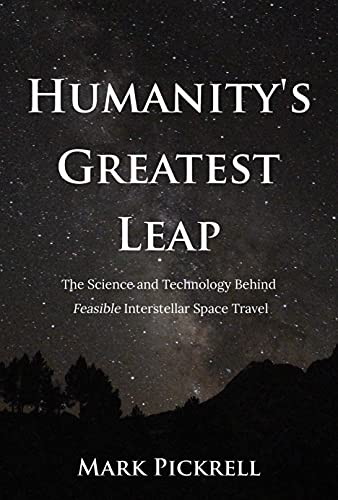
For anyone who has ever dreamed of our species’ future among the stars, Humanity’s Greatest Leap: The Science and Technology Behind Feasible Interstellar Space Travel by Charles Mark Pickrell will be a revealing and inspiring look at our world’s potential. This accessible deep dive on matter/anti-matter technology will be a scientific revelation for some, and will fill in some eye-opening gaps in our current technology for others.
Delving briefly into the history of atomic physics, and the fundamental aspects of matter/anti-matter, readers are slowly presented with a picture of how long-distance, high-speed space travel could be achieved. Although the technology has existed for less than 15 years, the exciting applications of gamma ray-powered space flight have already inspired a new generation of astrophysicists and engineers. By capturing and containing huge amounts of positrons and electrons (via lasers), and encouraging them to annihilate via magnetic manipulation, a significant and sustained amount of gamma rays can be created and directed as a means of propulsion.
Aside from the theoretical application of this technology, there are also technical diagrams of the proposed spacecraft, which will help lay readers visualize this somewhat abstract concept. As the subtitle of the book makes clear, this is not some sci-fi dream of a Dyson sphere or other tech that still lies generations out of reach. This matter/anti-matter tech exists today, and could be used to power ships to other stars by the end of the century, if not sooner. By putting the reality of this technology into common, engaging language, along with relatable anecdotes and timescales, the realm of advanced physics and space travel no longer feels like the domain of the academic, astronomical, or engineering elite.
Perhaps the most interesting part of the book for veteran space lovers is the prospect of faster-than-light technology. While this may sound like “Star Trek” fan fiction, the author explains that while major technological breakthroughs are necessary for such a feat, this book’s matter/anti-matter concept is a key stepping stone towards achieving speeds greater than the speed of light, effectively pushing the boundaries of physical reality as we know it.
The book closes on a hopeful note, one of unity and shared purpose among the international community. As we are beginning to see more and more with the effects of climate change, the largest problems on our planet affect us as a species, not as individual nations. Pickrell addresses this, stating that matter/anti-matter research should be “an international endeavor,” and though different strategies and tacks may be applied, the achievement of such technology would be a substantial victory for the planet.
On the technical side of things, there are a few grammatical errors and misspelled words, as well as some anecdotal tangents that seem to ramble more than necessary. As a whole, however, the book is ordered in an intuitive way, the facts are laid out without bias or emotion, and the foundational science is well-cited and explained, while the more philosophical and sociological impacts are explored with a similar level of curiosity and clarity. This brief guide to a massively important prospect sparks the imagination and reminds readers just how much discovery still lies ahead.
Available At


















Leave A Comment